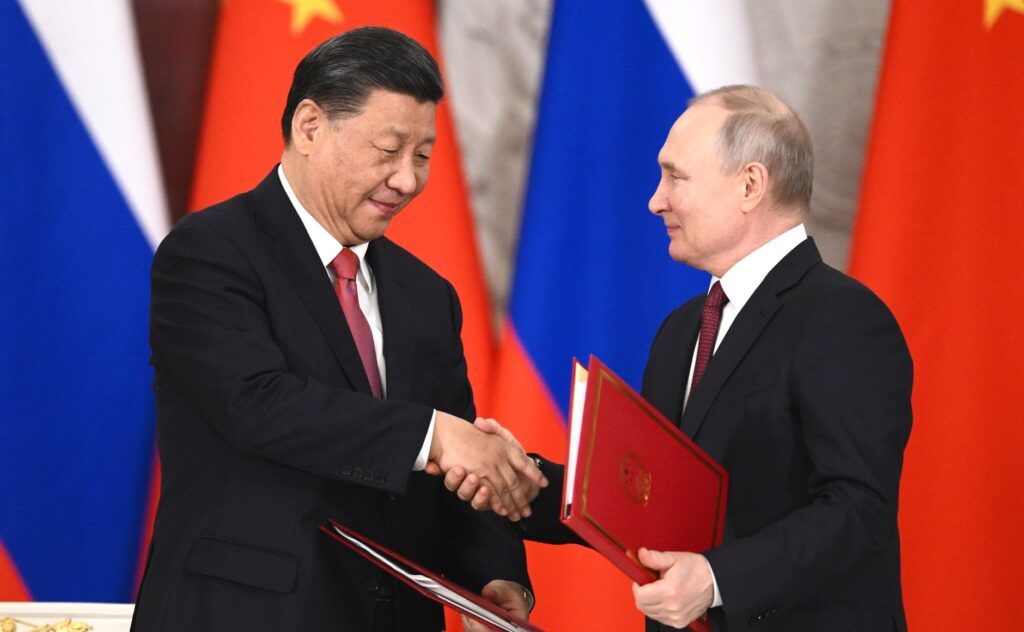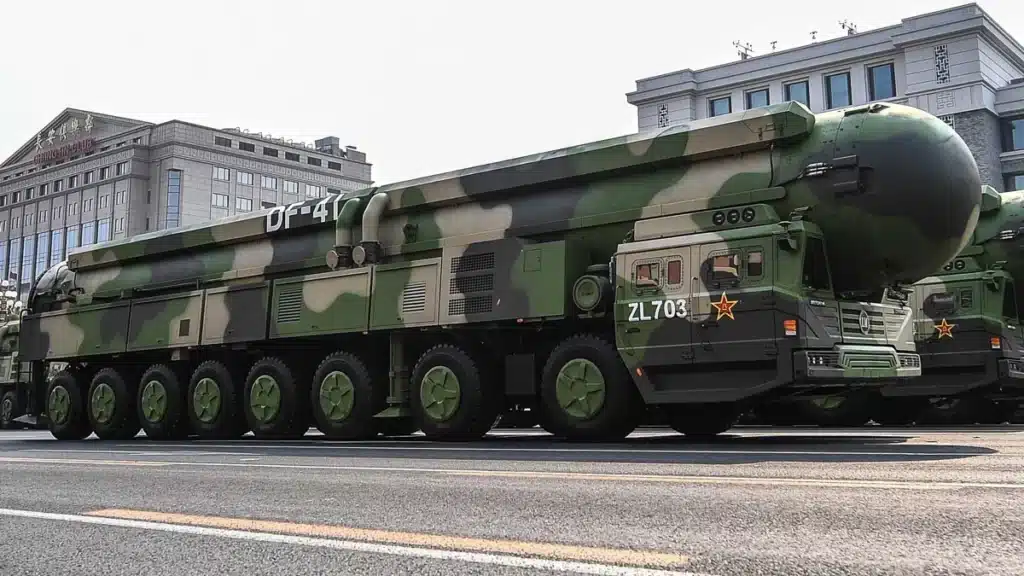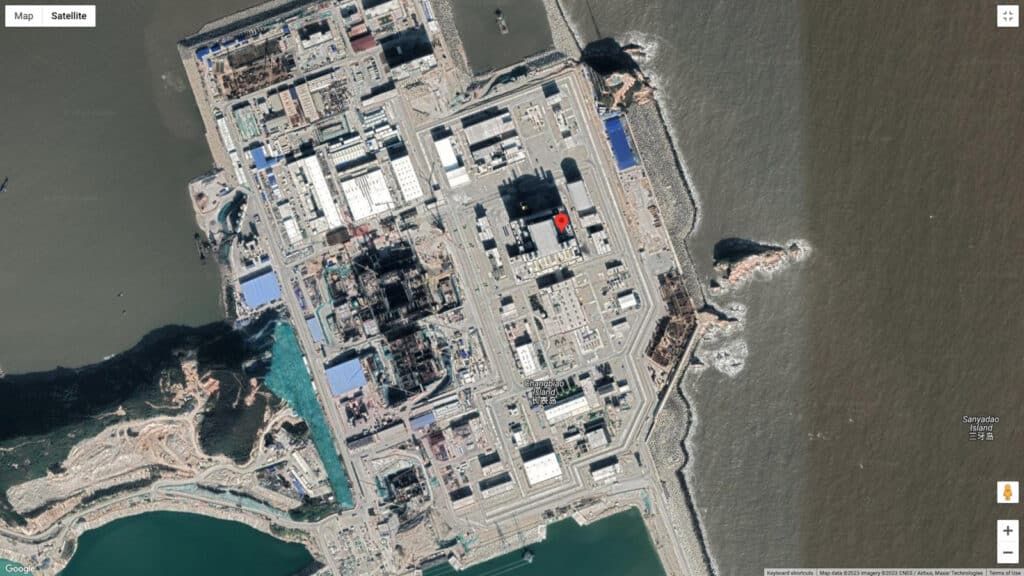How Chinese military aid to Russia could lead to a strategic reversal of nuclear forces
By Vladimir Marakhonov | April 17, 2023
 Chinese President Xi Jinping meets with Russian President Vladimir Putin in Moscow on March 21, 2023. US experts fear China may provide military aid to Russia in exchange for help to quickly build up its nuclear forces. (Photo: Vladimir Astapkovich, RIA Novosti via Kremlin.ru)
Chinese President Xi Jinping meets with Russian President Vladimir Putin in Moscow on March 21, 2023. US experts fear China may provide military aid to Russia in exchange for help to quickly build up its nuclear forces. (Photo: Vladimir Astapkovich, RIA Novosti via Kremlin.ru)
In the new Biden administration’s National Security Strategy,[1] announced on October, 12, 2022, China is declared to be the only competitor of the United States. The strategy states “[China] and Russia are increasingly aligned with each other but the challenges they pose are, in important ways, distinct. We will prioritize maintaining an enduring competitive edge over [China] while constraining a still profoundly dangerous Russia.” The document adds that Russia is no longer considered to be a competitor to the United States although it “poses an immediate and ongoing threat to the regional security order in Europe and it is a source of disruption and instability globally but it lacks the across the spectrum capabilities of [China].”
But China faces many challenges to quickly build up its nuclear forces—and may have sought the help of a newfound ally: Russia. While Russia’s nuclear weapons industry is increasingly showing signs of underperformance that could affect its strike capabilities in a nuclear conflict, it has several ways by which it can support the development of China’s program, including the possible transfer of some of its weapons-grade plutonium. This de facto Russian-Chinese strategic alliance—once thought to be unlikely—could have far-reaching implications for the balance of forces between the world’s largest nuclear powers.
Russian nuclear forces are unmatched. The United States may consider China its only long-term competitor, the current balance of nuclear forces shows a different picture: According to the Federation of American Scientists, in 2023, Russia owned a stockpile of 4,489 nuclear warheads, including 1,674 deployed warheads and 2,815 in reserve,[2] whereas the United States had 3,708, including 1,770 deployed,[3] and China had 404 warheads with more in production.[4] China’s nuclear stockpile is no match to those of Russia and the United States.
Because China is not a party of New START—a treaty limiting US and Russian strategic nuclear forces that was suspended by Russia in February 2023—it is not subject to mutual inspections and therefore has more opportunities to conceal information about its nuclear forces than the United States and Russia. That’s why many experts doubt China’s official data and think that the actual number of Chinese nuclear warheads may be larger than publicly acknowledged. But even if that’s the case, the estimated capacity of Chinese reactors and industries is unlikely to produce enough weapons-grade plutonium to exceed the official number of warheads substantially.
In addition, past US Defense Department’s projections have consistently and significantly overestimated and misrepresented China’s real nuclear threat.[4] According to the latest Pentagon report, China’s nuclear arsenal is not expected to exceed 1,000 warheads in 2030 and 1,500 warheads in 2035[5]—totals far below US and Russian arsenals.
Given that China’s nuclear forces currently are much weaker than Russia’s, it seems somewhat strange—even humiliating—for Russia to be excluded from the list of America’s future military rivals. Even if Russia may lack the across-the-spectrum capabilities that China has, in the military part of that spectrum, its nuclear line is incomparably brighter than China’s—and will remain so for the foreseeable future.
No doubt that the US experts who advised the Biden administration to shift its strategy had some serious grounds for their assessment. The problem is that the public might never know what those grounds are. However, some assumptions can be made.
Are Russian nuclear forces reliable? In the 2022 invasion of Ukraine, Russia’s conventional armed forces dramatically underperformed expectations. Russian precision-guided conventional weapons faced serious difficulties in reaching their targets, often hitting civilian buildings instead of military facilities. It is reasonable to wonder whether a similar underperformance could affect Russian nuclear forces if a nuclear conflict erupts. Some signs suggest that it may indeed be possible.
The most powerful Russian missile, the SS-18 M6 “Satan” (RS-20V), can carry up to 10 warheads.[6] Designed in the Ukrainian “Yuzhnoe” bureau and produced also in the Ukranian factory “Yuzhmash” in the Soviet city Dnepropetrovsk (now Ukrainian Dnepr), the missiles were first deployed in 1988. They started to be formally retired in 2021, after more than 30 years in service and combat duty,[2] after their 10-year warranty period was extended at least three times. The missiles and supporting equipment seriously depended on careful service and maintenance provided by the producer to ensure their safety. After the 2014 Crimea annexation, the service and maintenance of this complicated system were judged too difficult to continue, and the “Satan” missiles on duty began to be terminated. At the time, more than half of Russian ICBM warheads were being deployed on these missiles.
A new project—the similar heavy missile, the SS-X-29 “Sarmat” (RS-28)—has been started to replace the old Satan missiles. Some media have called this new missile the “Son of Satan.” The new “Sarmat” missile will be produced in Russia and assembled exclusively with Russian parts. The first (and still only) flying test of the new missile was carried out in April 2022. President Putin announced “Sarmat” would be put into service at the end of 2022. But in December 2022, he was forced to admit that the project was being postponed indefinitely.[7] Then, on March 22, 2023, CNN reported that two unidentified US officials said the test of “Sarmat” likely had failed.[8]
Dysfunction in Russian military industry. This failure—and earlier problems, including widely reported failed tests of the “Bulava” (RSM-56) submarine-launched ballistic missile—might be a result of deficiencies in the Russian military industry known to exist since the 1990s. Such problems include a human resources’ crisis caused by a lack of young recruits, corruption that is widespread in the Russian economy, and technical incompetence and lack of professionalism in an upcoming wave of top executives in military industries.
To make matters worse, dubious “high treason” cases against scientists employed in the Russian military industry have increased dramatically since 2014. To date, more than 50 cases have been made public;[9] per the Russian Criminal Code, the scientists accused of high treason risk imprisonment for up to 20 years. Most of the scientists arrested were elderly leaders in their field who had made many scientific connections abroad in the past—connections that make them particularly vulnerable to wrongful accusations and imprisonment. Several of the scientists charged have died in prison.
The FSB—Russia’s main security agency and successor to the old KGB—typically does not disclose details about treason accusations, but when they do become public, the cases often turn out to seem far-fetched. In one instance, scientists were accused of disclosing classified information about Russia’s submarine launched ballistic missiles while giving lectures at the Harbin University of Science and Technology in northeastern China, even though the content of those lectures had been reviewed and approved by the FSB beforehand. These cases have, to say the least, negatively affected the working environment in Russia’s defense science and industry.

A Chinese-Russian strategic alliance. Russia faces problems with the production of nuclear warhead carriers, as well as with its military production, research, and development in general. These problems are connected, in part, to the embargo on the import of modern electronics and other high-tech due to the Russia-Ukraine war.[10]
China has a developed military industry, which has led to significant progress in the production of launch vehicles in recent years. Yet it cannot quickly increase the number of its thermonuclear warheads because of the lack of internal sources of weapons-grade plutonium.[11]
Taking new reactors under construction into account, it is estimated that China could have about 1,270 warheads by 2030[11]—more than Pentagon’s estimate of 1,000,[5] but still not enough to bring it to parity with the United States or Russia.
Given its limited plutonium resources, China may find it difficult to become a full-fledged nuclear opponent of the United States in the near future without seeking—and getting—some external help. Already in the past, China acted as if Russia was its ally against the United States. For example, in 2017, China deployed some of its DF-41 intercontinental ballistic missiles in the province of Heilongjiang in northern China near its border with Russia.[12] From this position the DF-41 missiles could reach most part of homeland United States through the North Pole, outside the range of the American Aegis anti-missile system located in the Pacific region.
The uncertain political future of the current Russian regime—driven by its protracted war against Ukraine and its growing economic and political isolation—likely does not encourage China to view Russia as a full-fledged and reliable ally in the long term. But current circumstances may prompt China to try to take advantage of Russia’s weakness to solve its own nuclear problems.

Is Russia helping China’s nuclear buildup? There are several ways in which China could use Russia to achieve its nuclear weapons development objectives.
First, Russia may supply China with more uranium fuel for its reactors. On March 1, Bloomberg reported that Russia had delivered about 6.5 tons of highly-enriched uranium to China for its CFR-600—a fast-neutron nuclear reactor under construction on Changbiao Island in southeast China.[13] This has caused serious concerns among US experts who see the delivery as a confirmation that Russia is helping China’s nuclear forces buildup. (Fast-neutron reactors can produce weapons-grade plutonium, which can then be used for manufacturing nuclear weapons.) But according to Princeton University physicist and former White House adviser Frank von Hippel, the CFR-600 reactor could produce fissionable material for a maximum of 50 warheads per year. China might therefore look for quicker opportunities to achieve its nuclear development objectives.
The most obvious quick fix could be for Russia to transfer some of its own nuclear warheads to China. This is not allowed under the Treaty on the Non-Proliferation of Nuclear Weapons (NPT), which Russia ratified and which prohibits a party to transfer its nuclear weapons to any recipient. But even if there was no such a restriction, it is difficult to conceive that Russia would transfer some of its nuclear warheads to China. Despite their circumstantial alliance, Russia and China have had border conflicts and territorial disputes in the past; it is highly unlikely that one of the two neighboring authoritarian countries would disarm itself to arm the other.
The same NPT prohibits transferring source or special fissionable material to a non-nuclear-weapon country, but the treaty does not cover the transfer of such materials to a nuclear-armed country. Russia could provide China with some amount—small or large—of weapons-grade plutonium without breaching the NPT.
The United States and Russia agreed to dispose of significant fractions of their inventory of weapons-grade plutonium declared as in “excess” (i.e., beyond what they need for their nuclear weapons) under the Plutonium Management and Disposition Agreement that they signed in 2010 (amended version). But Putin ordered the suspension of the agreement on October 3, 2016, following the failure by the United States to build its own MOX fuel fabrication plant at the Savannah River Site in South Carolina to recycle its excess plutonium.[14]
Russia has declared 50 metric tons of plutonium in its stockpiles as excess.[15] It is enough to produce about 14,000 warheads.[10] Part of this inventory, theoretically, could be sold to China. Such an action seems to be almost as dubious as transferring nuclear warheads to its neighbor. But, at least in this case, the transfer of excess plutonium to China would not lead to a decrease in the number of nuclear warheads owned by Russia.
There is therefore a legal and technical opportunity for China to dramatically increase the number of its nuclear warheads earlier than 2030. If this happens, China could become the main strategic competitor of the United States much sooner—and without any doubts or reservations—than experts anticipated when advising the Biden administration’s National Security Strategy.
Risk of strategic balance reversal. It remains uncertain what circumstances would lead Russia to help China achieve its nuclear objectives. Most likely, before a plutonium transfer were seriously considered Putin would need to face a real threat to his leadership because of a failure to achieve success—or even outright defeat—in Ukraine. But even in this scenario, the current Russian regime would still need to maintain sufficient leadership to carry out a transfer of plutonium to China—an act that many in the Russian military would oppose.
It seems likely that the current US administration is aware of the potential threat of Russia-China cooperation about nuclear weapons. Some in Washington probably fear that a cornered Russian leadership may try to buy massive amounts of Chinese weapons by transferring weapons-grade plutonium, in a short-term military trade that would have severe, long-term strategic consequences. China, meanwhile, may have an interest in seeing Russia’s position worsening to the point where the Russian leadership will be willing to take any measure to save its own position, including accepting the idea of transferring plutonium to China. And for its part, Russian leadership could use the mere possibility of a plutonium transfer to China to covertly blackmail the US administration into reducing its support of Ukraine.
Although the possibility of a plutonium deal between Russia and China may seem an unlikely and sudden threat, it does not seem illogical. Since the start of Russia’s invasion of Ukraine, many unorthodox and unexpected political and military events have occurred. The transfer of plutonium by Russia to China could become just one of those.
Notes
[1] White House. 2022. “National Security Strategy.” October. https://www.whitehouse.gov/wp-content/uploads/2022/10/Biden-Harris-Administrations-National-Security-Strategy-10.2022.pdf
[2] Kristensen H. M., Korda M., and Reynolds E. 2023. “Nuclear Notebook: Russian nuclear weapons, 2023.” Bulletin of the Atomic Scientists, Forthcoming in May. https://thebulletin.org/nuclear-risk/nuclear-weapons/nuclear-notebook/
[3] Kristensen H. M., and Korda M. 2023. “Nuclear Notebook: United States nuclear weapons, 2023.” Bulletin of the Atomic Scientists, January 16. https://thebulletin.org/premium/2023-01/nuclear-notebook-united-states-nuclear-weapons-2023/
[4] Kristensen H. M., Korda M., and Reynolds E. 2023. “Nuclear Notebook: Chinese nuclear weapons, 2023.” Bulletin of the Atomic Scientists, March 13. https://thebulletin.org/premium/2023-03/nuclear-notebook-chinese-nuclear-weapons-2023/
[5] US Department of Defense. 2022. “Annual Report to Congress: Military and Security Developments Involving the People’s Republic of China 2022.” Office of the Secretary of Defense, November 29. https://media.defense.gov/2021/Nov/03/2002885874/-1/-1/0/2021-CMPR-FINAL.PDF
[6] The Nuclear Notebook estimates that Russia’s SS-18s now carry only five warheads each to meet the New START limit. However, in addition to active warheads, the SS-18 may also carry a large amount of anti-interception devices such as decoys.
[7] RBC. 2022. “Путин выступил на коллегии Минобороны.” December 21. https://www.rbc.ru/politics/21/12/2022/63a2d7909a7947f5fd0317ba
[8] Liebermann O., and Bertrand N. 2023. “US believes Russia had failed intercontinental ballistic missile test around when Biden was in Ukraine.” CNN, February 22. https://edition.cnn.com/2023/02/21/politics/russia-intercontinental-ballistic-missile-test/index.html
[9] Chelischeva V. 2020. “ФСБ ведет охоту на ученых.” Novaya Cazeta, November 27. https://novayagazeta.ru/articles/2020/11/27/88134-berut-lyudey-s-opytom-lomayut-zhizni-otnimayut-rabotu-i-zdorovie
[10] Interfax. 2023. « Еврокомиссия предложила запретить поставки в РФ 47 видов компонентов для электроники» Февраль 2023. Интерфакс, February 15. https://www.interfax.ru/world/886316
[11] Cochran T.B., and Sokolski H.D. 2021. “How Many Nuclear Warheads China Might Acquire by 2030.” in “China’s Civil Nuclear Sector: Plowshares to Swords?” In Henry. D. Sokolski, ed., Occasional Paper 2102, March. http://npolicy.org/article_file/2102_Chinas_Civil_Nuclear_Sector.pdf
[12] Global Times. 2017. “Dongfeng-41 will bring China more respect.” January 25. http://en.people.cn/n3/2017/0125/c90000-9171195.html
[13] Tirone J. 2023. “China’s Imports of Russian Uranium Spark Fear of New Arms Race.” Bloomberg, March 1. https://www.bloomberg.com/news/articles/2023-03-01/china-nuclear-trade-with-russia-risks-tipping-military-balance
[14] Russian Federation. 2016. “Указ Президента Российской Федерации от 03.10.2016 № 511.” October 3. http://publication.pravo.gov.ru/Document/View/0001201610030004
[15] Podvig P. 2016. “Can the US-Russia plutonium disposition agreement be saved?” Bulletin of the Atomic Scientists, April 28. https://thebulletin.org/2016/04/can-the-us-russia-plutonium-disposition-agreement-be-saved/
Together, we make the world safer.
The Bulletin elevates expert voices above the noise. But as an independent nonprofit organization, our operations depend on the support of readers like you. Help us continue to deliver quality journalism that holds leaders accountable. Your support of our work at any level is important. In return, we promise our coverage will be understandable, influential, vigilant, solution-oriented, and fair-minded. Together we can make a difference.
Keywords: Biden administration, China, NPT, National Security Strategy, Russia, US-China competition, United States, nuclear balance
Topics: Nuclear Weapons, Opinion














